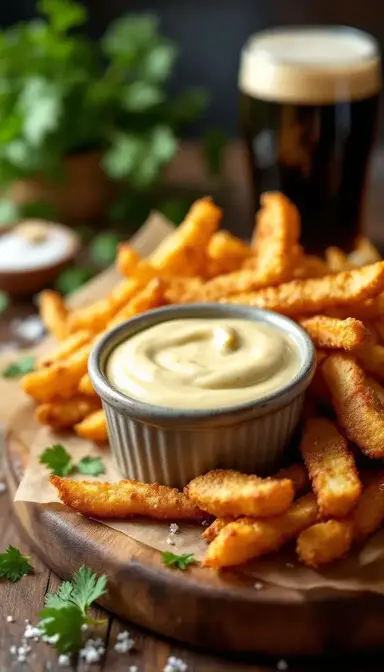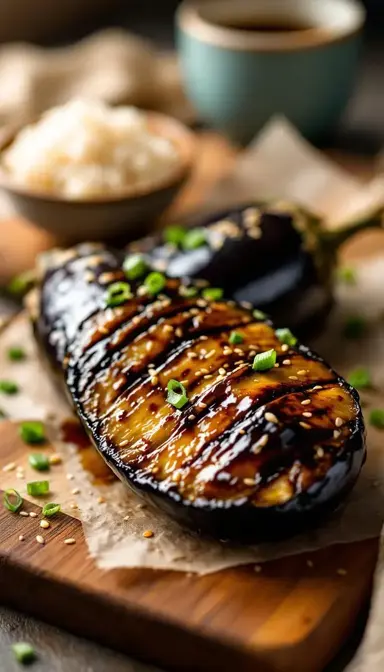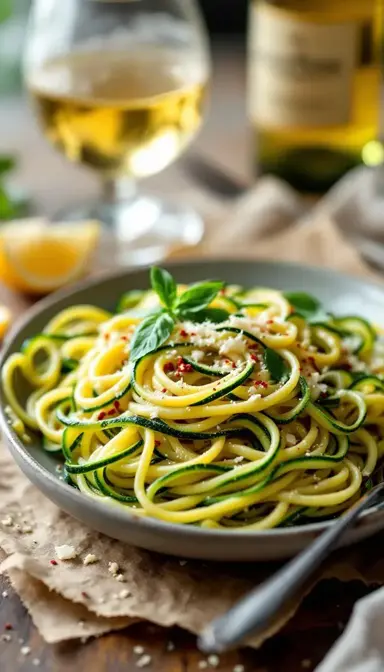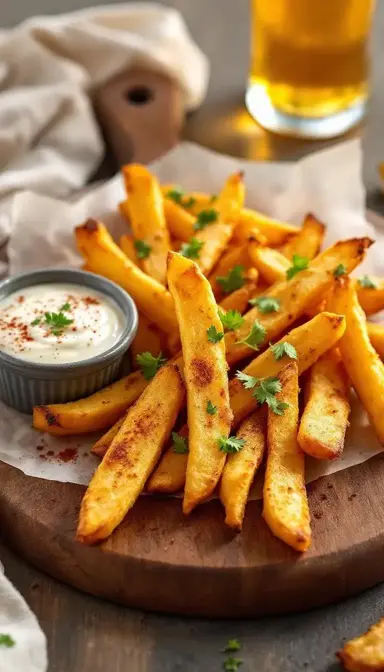Let’s talk about fries—real fries. Not the sad, limp kind that surrender under the weight of ketchup, but the kind that crackle when you bite into them, revealing a cloud-like interior. That’s the magic of double-fried fries, a Belgian trick that turns humble potatoes into golden wands of joy. Whether you’re pairing them with a dripping cheeseburger or devouring them straight from the bowl (no judgment here), this method is your ticket to fry nirvana.
Why This Recipe Works
- Two-stage frying: Low and slow first to cook the inside, then hot and fast to build that irresistible crust. The first fry at 325°F gently cooks the potato’s interior without browning, while the second fry at 375°F triggers the Maillard reaction for deep flavor and crunch.
- Russet potatoes: Their high starch content ensures a fluffy interior and crispy exterior. Yukon Golds can substitute for a creamier texture, but soak them longer (45 minutes) to prevent excess browning.
- Cold water bath: Soaking pulls out excess starch, preventing fries from sticking together or turning gummy. Adding vinegar to the water keeps them from discoloring.
Why You’ll Love These Fries
- Texture heaven: A shatteringly crisp exterior gives way to a tender, fluffy middle. The double-fry method creates an unmatched contrast.
- Versatile: Cut them thick for steak fries, skinny for shoestrings, or somewhere in between. Uniformity is key for even cooking.
- Prep-friendly: Par-fry them ahead of time, then finish when you’re ready to serve—ideal for entertaining.
Essential Ingredients & Tools
Ingredients
- 4 large Russet potatoes: The starchier, the better. Yukon Golds work too, but they’ll be creamier, not as fluffy.
- 1 quart peanut or vegetable oil: High smoke point means no burnt flavors. Save the olive oil for salad.
- 1 tbsp white vinegar: Toss it in the soaking water to keep your potatoes from turning gray.
- 2 tsp kosher salt: Season while they’re hot—salt sticks better when the fries are fresh from the fryer.
Tools
- Dutch oven or heavy pot: Keeps the oil temperature steady. A deep skillet works in a pinch.
- Spider strainer or slotted spoon: For fishing out fries without splattering oil everywhere. A mesh sieve can substitute.
- Thermometer: Eyeballing it won’t cut it—precision is key. A candy thermometer works if you don’t have a fry thermometer.
- Paper towels or wire rack: Drain excess oil so your fries stay crisp, not greasy.
Serves: 4 | Prep: 30 min | Cook: 20 min | Total: 50 min
How to Make The Secret to Perfectly Crispy Double-Fried Fries
- Prep the Potatoes
Peel them if you like (I usually don’t—more texture!), then cut into even ½-inch sticks. Soak in cold water with 1 tbsp white vinegar for 30 minutes. This step is non-negotiable—it washes away excess starch, which means crispier fries. Dry them thoroughly with a kitchen towel. Any moisture left will make the oil spit like an angry cat.
- First Fry (The Foundation)
Heat 1 quart peanut or vegetable oil to 325°F (163°C). Fry in small batches—crowding the pot is a one-way ticket to soggy fries. Cook for 5–6 minutes until they’re soft but still pale. This is just to cook the inside; they won’t look like fries yet. Transfer to a wire rack (never a pile—steam is the enemy of crunch).
- The Waiting Game
Let them cool completely, about 15 minutes at room temp. If you’re prepping ahead, you can refrigerate them for up to 2 hours. This rest period is crucial—it lets the starches firm up so the second fry turns them into crispy perfection.
- Second Fry (The Grand Finale)
Crank the oil to 375°F (190°C). Fry the same batches again for 2–3 minutes until they’re deep golden and audibly crunchy. This is where the magic happens—the Maillard reaction works its flavor sorcery. Drain on fresh paper towels and hit them with 2 tsp kosher salt immediately.
- Serve Immediately
Fries are at their peak for about 5 minutes. If you want to gild the lily, toss them with melted duck fat or a dusting of smoked paprika.
Pro Technique
Oil Temperature is Everything
The first fry at 325°F is about cooking the inside without browning. Too hot, and the outside hardens before the inside softens. Too low, and they’ll soak up oil like a sponge. Trust your thermometer.
Cooling is Not Optional
Skipping the rest between fries? That’s like skipping the foundation when building a house. Cooling lets moisture escape, so the second fry delivers maximum crunch. Spread them out—no stacking!
Small Batches Win
Overcrowding drops the oil temp, leading to greasy fries. Stick to 1 cup of raw potatoes per quart of oil, and let the oil come back to temp between batches.
Chef’s Wisdom
Dry or Die
Moisture is the arch-nemesis of crispiness. After soaking, pat those potatoes like you’re trying to erase their sins. Even a little dampness will make the oil sputter and the fries steam instead of crisp.
Salt Like a Boss
Season right out of the fryer—heat helps the salt cling. Toss them in a bowl with salt for even coverage. Flaky kosher salt is your best friend here; fine salt just disappears.
Oil Management
Strain used oil through cheesecloth and store it in a cool, dark place. You can reuse it up to 3 times, but toss it if it smells off or smokes at low temps.
Storage & Freshness Guide
Freeze After the First Fry
Cool them completely, freeze in a single layer on a tray, then transfer to a zip-top bag. They’ll keep for 1 month. Fry from frozen at 375°F for 3–4 minutes.
Reviving Leftovers
Day-old fries can be saved! Reheat on a wire rack in a 400°F oven for 5 minutes to bring back the crunch. The microwave will only betray you.
Food Safety
Don’t leave cooked fries out for more than 2 hours. Store leftovers in a paper-towel-lined container (never airtight) in the fridge for up to 2 days.
Nutrition Profile
Let’s be real—these are a treat, not a health food. But hey, life’s too short for bad fries.
| Nutrient | Amount |
|---|---|
| Calories | 320 |
| Fat | 15g |
| Protein | 4g |
| Carbs | 42g |
| Fiber | 3g |
Ingredient Variations and Their Impact
Sweet Potato Fries
Swap Russets for sweet potatoes. They’re softer but packed with vitamins. Toss with cinnamon sugar for a sweet twist.
Duck Fat Upgrade
Use rendered duck fat instead of oil for fries that taste like they came from a Brussels bistro. Infuse it with rosemary and garlic for extra flair.
Yukon Golds
Creamier than Russets, but soak them longer (45 minutes) to prevent excess browning.
Seasoned Salts
Try truffle salt, Old Bay, or even powdered porcini mushrooms mixed with salt for a flavor bomb.
Beer-Battered Fries
Dip par-fried fries in a light lager batter before the second fry. For extra lift, use sparkling water in the batter.
Perfect Pairings
Complementary Dishes
- Burgers: The ultimate combo. The fries’ crunch contrasts with a juicy patty’s richness. Serve with garlic aioli for dipping.
- Beer-Battered Fish: Double the crunch, double the fun. The crisp fries mirror the fish’s coating.
Drinks
- Champagne: Its acidity cuts through the fries’ richness.
- Stout: The roasted malt flavors complement duck-fat fries.
Something Sweet
- Vanilla Milkshake: The cold, creamy sweetness balances the salty fries.
- Chocolate-Dipped Fruit: A light finish after a hearty meal.
Master this, and you’ll never look at frozen fries the same way again. Happy frying!

The Secret to Perfectly Crispy Double-Fried Fries
Learn how to make perfectly crispy Double-Fried Fries at home with my easy, step-by-step guide. Golden, crunchy, and totally irresistible—get the recipe now!
Ingredients
-
4 large Russet potatoes
-
1 quart peanut or vegetable oil
-
1 tbsp white vinegar
-
2 tsp kosher salt
Instructions
-
Peel and cut potatoes into ½-inch sticks. Soak in cold water with 1 tbsp white vinegar for 30 minutes. Dry thoroughly.01
-
Heat 1 quart peanut or vegetable oil to 325°F. Fry potatoes in small batches for 5–6 minutes until soft but pale. Transfer to a wire rack.02
-
Let cool completely (15 minutes at room temp or up to 2 hours in the fridge).03
-
Increase oil to 375°F. Fry again for 2–3 minutes until golden and crisp. Drain and season with 2 tsp kosher salt immediately.04
-
Serve hot.05



